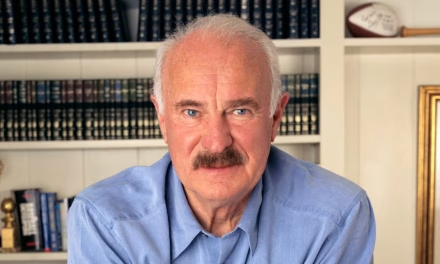Ron Cobb, the underground cartoonist turned production designer who influenced the making of E.T. the Extra-Terrestrial and helped shape the worlds of Conan the Barbarian, Alien and Back to the Future, has died. He was 83.

Cobb died Monday — his birthday — of Lewy body dementia in Sydney,Australia, his wife of 48 years, Robin Love, reported.
Cobb’s designs have graced or influenced nearly every science fiction movie made since his made his debut as a designer on John Carpenter’s first film, Dark Star, written by Dan O’Bannon. Later O’Bannon would pen the script for Alien, and Cobb provided extensive designs. It was Cobb’s idea that the aliens’ blood should be corrosive, thereby solving a plot hole such that the protagonists couldn’t just shoot or mutilate them.
Cobb designed several of the creatures in the Mos Eisley Cantina for Star Wars (1977), designed weaponry and sets for Conan the Barbarian (1982), the exterior and interior of the Nostromo ship in Alien (1978) and the earth colony complex in Aliens (1986), and the the iconic DeLorean time machine in Back to the Future (1985).
The hand of Ron Cobb was everywhere. His design work appeared in The Abyss (1989), the Omega Sector logo and the H bombs in True Lies (1990), the interior of the Mothership and the stranded tanker in Close Encounters of the Third Kind (1977) and the vehicles and some of the hand props of The Last Starfighter (1984).
It was while working as a production designer on John Milius’ Conan the Barbarian that Cobb first met Steven Spielberg, who was working down the hallway at Universal on Raiders of the Lost Ark. Spielberg was so impressed by Cobb’s apparent natural ability as a visual storyteller that he suggested Cobb direct his future film Night Skies, a retelling of an infamous 1955 incident in Kentucky in which a family claimed to have had an encounter with five aliens at their farmhouse.
When the family in question threatened to sue to stop the making of the movie, Cobb offered to write a similar story, with the last scene showing an alien marooned on Earth. The project was shelved when they realized it was going to cost upwards of $3.5 million to create the five aliens — until Spielberg reverted to an idea he had of a boy who protects an abandoned alien. That film was E.T. the Extra Terrestrial (1982).
Cobb was given a cameo as a doctor in that film but he didn’t think much of the finished product. Years later, Cobb’s wife noticed that there was a $7,500 “kill fee” in his Night Skies contract — plus 1 percent of the net profits — should he not get to direct the movie. She sent off an invoice to Universal and received an envelope with a check inside for more than $400,000.
Cobb began his career at Disney at age 17 as an “inbetweener” animator on Sleeping Beauty (1959).
Cobb was a celebrated editorial cartoonist for underground newspapers after submitting cartoons to the Los Angeles Free Press, which in the 1960s was operating out of the basement of the Fifth Estate coffee house on the Sunset Strip. His counterculture work was syndicated in more than 80 newspapers across America, Europe, Asia and Australia.








A collection of his cartoons was published in 1974 and ’76 in The Cobb Book and Cobb Again, and his movie illustrations were collated in the large-format publication Colorvision. He also designed covers for Forrest Ackerman’s Famous Monsters of Filmland magazine.
In the early 1970s, Cobb performed speaking tours around Australia and New Zealand on request of the Aquarius Foundation, a cultural branch of the Australian Union of Students. The tour was run by his future wife, and they would co-write a 1987 episode of the Twilight Zone reboot.
A former draughtsman with the Army Corps in Vietnam, Cobb is survived by his wife and a son, Nicky.
-30-
![]()
SCIFI.radio is listener supported sci-fi geek culture radio, and operates almost exclusively via the generous contributions of our fans via our Patreon campaign. If you like, you can also use our tip jar and send us a little something to help support the many fine creatives that make this station possible.












